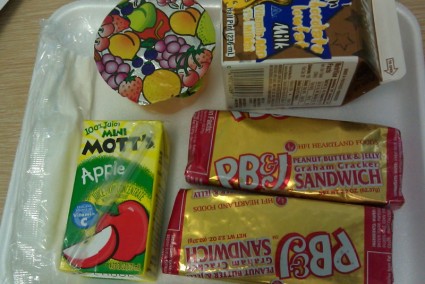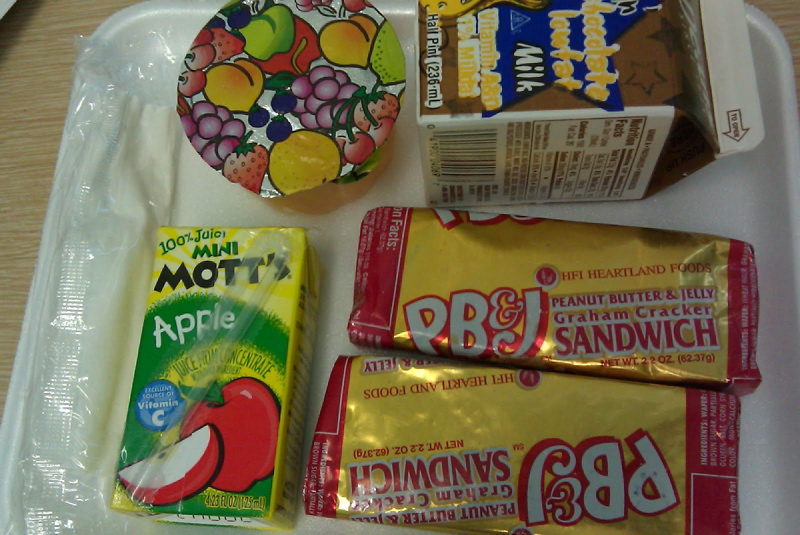 Where does your food come from? In this Illinois public school, the answer is: plastic. Photo: Fed Up: School Lunch Project blogI normally don’t have much time for blog stunts–you know, I’m going to cook my way through such-and-such famous cookbook in a year, or stop using toilet paper, and then roll out a book and a movie. (By the way, still waiting for that bidding war over Meat Wagon rights.)
Where does your food come from? In this Illinois public school, the answer is: plastic. Photo: Fed Up: School Lunch Project blogI normally don’t have much time for blog stunts–you know, I’m going to cook my way through such-and-such famous cookbook in a year, or stop using toilet paper, and then roll out a book and a movie. (By the way, still waiting for that bidding war over Meat Wagon rights.)
But here’s a blog stunt worth studying–one that trains a withering gaze on the way we as a society treat children.
Working from an unnamed Illinois school, an anonymous teacher calling herself Mrs. Q vows to eat what’s being served up in the cafeteria each day, and chronicle the experience with a simple photograph and a few lines. Mrs. Q opened her blog, called “Fed Up: School Lunch Project,” like this:
It’s very challenging to teach students when they are eating school lunches that don’t give them the nutrition they need and deserve. Oftentimes what is served barely passes muster as something edible. And after a meal high in sugar and fat and low in fiber, they then must pay attention in a classroom.
I’m going to attempt to eat school lunch everyday in 2010. As a teacher it’s available to me for $3.00. Most of the students at my school get free lunch or reduced ($0.40). I’m going to take pictures of the school lunch and post them.
Normally I shop for organic fruits and veggies. I avoid processed foods and food high in sugar and high fructose corn syrup, but I normally eat food brought from home, including leftovers, a sandwich, or a “healthy” microwave meal for lunch with yogurt and a piece of fruit.
In the posts that follow, we get a simple, powerful exposé of how our schools teach kids–specifically kids from low-income families–that food is flavorless junk plunked down on little paper plates, wrapped in plastic, and heated.
The amount of packaging documented here is stunning–even the cheese sandwich comes pre-wrapped. Beyond the obvious mountain of waste, you have to wonder about the wisdom of serving kids food heated in plastic–given what we know about the link between plastics and serious health problems.
Of the dismal food on display, what struck me as most tragic was the “PB&J” entree. Now, peanut butter-and-jelly sandwiches are pretty simple operations, as culinary projects go. You take two slices of bread, spread peanut butter on one, jelly on the other, and combine. But in Mrs. Q’s school cafeteria, it seems, no cooking at all takes place–and “PB&J”‘s are procured pre-made and wrapped.
Let’s just say that Mrs. Q found the resulting sandwich impressive–but not in a good way.
In a recent interview, Mother Nature News asked Mrs. Q why she started the blog. Her reply:
I just have seen what the kids eat at my school and it makes me sad. I know that I feel bad about myself when I eat food I know is bad for my body. The last thing that the kids from my school need is to feel even worse about their circumstances. The meals send a message to the kids that they are not cared about.
Her blog is really about the withering away of the state–about what happens when the state pulls back from its responsibilities to its citizens and lets private-sector “solutions” like pre-wrapped PB&Js fill the void.
As Congress considers the School Nutrition Reauthorization Act, I hope Mrs. Q’s blog generates plenty of attention–and a book contract and move deal for its intrepid author.



